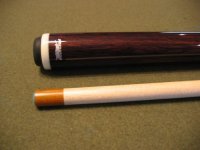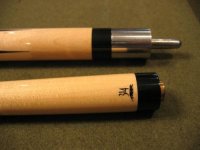Is the see saw tilting the other way now???
Too light and you have no mass to propel the CB....To heavy and you can't generate any cue speed and or lose control of the cue.
There is a middle ground number in there somewhere....but it will be different for everyone and every cue/shaft/tip set up...
Same with the Shaft..
The break cues that have "tree trunk" shafts....sure they are stiffer for more control, but you lose control if you can't get your fingers around the shaft....Too small a shaft and it has too much deflection to control where the CB is going
Too light and you have no mass to propel the CB....To heavy and you can't generate any cue speed and or lose control of the cue.
There is a middle ground number in there somewhere....but it will be different for everyone and every cue/shaft/tip set up...
Same with the Shaft..
The break cues that have "tree trunk" shafts....sure they are stiffer for more control, but you lose control if you can't get your fingers around the shaft....Too small a shaft and it has too much deflection to control where the CB is going

